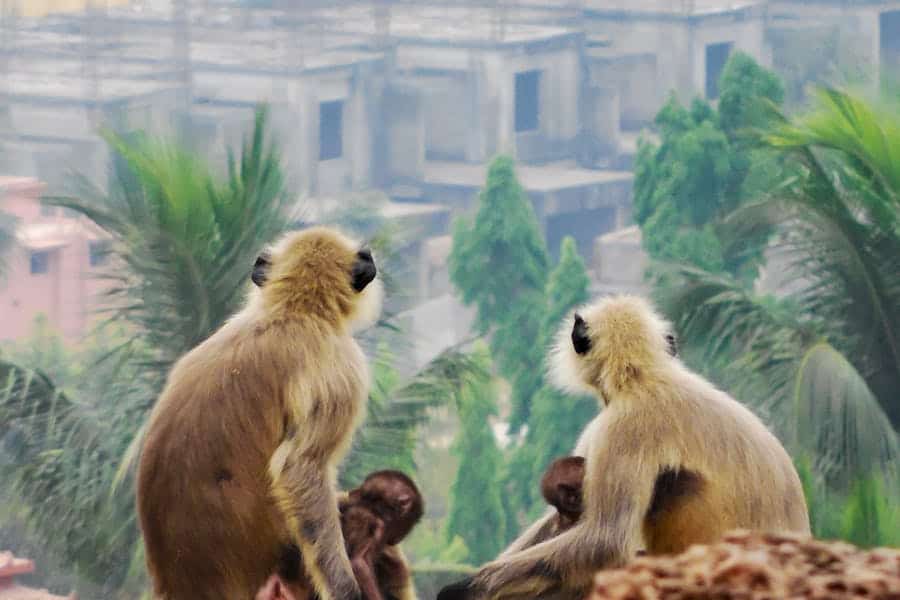Curious about whether monkeys roam the Sunshine State? Discover the truth behind Florida’s wild monkey population. While not native to Florida, rhesus macaques and a few green monkeys have established themselves in the state, particularly around Silver Springs State Park and other wooded areas in Central Florida. Originally introduced in the 1930s as a tourist attraction, these monkeys have adapted to their new environment. Although their presence adds an intriguing element to Florida’s wildlife, it’s important to understand the impact on local ecosystems and follow guidelines for safe interactions. This article explores the history, current status, and ecological implications of monkeys in Florida, offering insights into where you might spot them and how they influence the local environment.
Is There Monkeys In Florida?
Yes, there are monkeys in Florida! Rhesus macaques, introduced in the 1930s for tourism, have established a wild population, especially around Silver Springs State Park. While green monkeys have also been spotted, they’re less common. If you visit these areas, you might see them, but remember to observe from a distance and follow local wildlife guidelines.
What Species Of Monkeys Can Be Found In Florida?
Florida is home to a unique mix of wildlife, and among its diverse inhabitants are a few notable monkey species. While not native to the state, these monkeys have managed to establish themselves and become a curious part of Florida’s natural landscape.
Rhesus Macaque: The rhesus macaque is the most prominent monkey species found in Florida. Originally from Asia, these medium-sized primates were introduced to the state in the 1930s as part of a tourist attraction at Silver Springs State Park. Over the years, some of these macaques escaped captivity and began to establish a wild population. Today, they can be commonly seen in the Silver Springs area and other parts of Central Florida. Rhesus macaques are adaptable and thrive in the park’s wooded and swampy environments. They are recognizable by their tan or brown fur, pink faces, and long tails.
Green Monkey: The green monkey, native to Africa, is another species occasionally spotted in Florida. These monkeys are less common than the rhesus macaques but have been reported in some areas of Central Florida. Green monkeys are characterized by their olive-green fur, white underparts, and distinctive black faces. They are agile climbers and can often be seen in tree canopies, where they search for food and shelter.
Other Species: While rhesus macaques and green monkeys are the primary species found in Florida, there have been occasional sightings of other non-native monkeys. However, these instances are rare and typically involve individuals or small groups rather than established populations.
Overall, the presence of these monkeys adds an intriguing element to Florida’s wildlife. Their unique history and adaptation to their environment make them a fascinating topic for wildlife enthusiasts and visitors alike.
Where Can You See Monkeys In Florida?
If you’re eager to spot monkeys in Florida, there are a few key locations where these intriguing primates are known to make their home. Here’s a guide to where you can catch a glimpse of monkeys in the Sunshine State:
1. Silver Springs State Park
Silver Springs State Park is perhaps the most famous location for monkey sightings in Florida. This park, located near Ocala, is known for its natural springs and lush, wooded areas. The rhesus macaques here are descendants of a group introduced in the 1930s for a tourist attraction. Over time, these monkeys escaped from their enclosures and established a wild population in the park. Today, they can frequently be seen around the riverbanks and in the forested areas of the park. The dense vegetation and natural water sources provide an ideal habitat for these primates.
2. Central Florida
Beyond Silver Springs, rhesus macaques have spread to other parts of Central Florida. Areas with dense forests and swampy conditions are ideal for these monkeys. If you’re exploring regions around the Ocala National Forest or other forested areas in Central Florida, you might encounter these macaques. Their presence is not confined to one specific location but rather spread throughout the region where they have adapted to the environment.
3. Lake County
Lake County, situated to the west of Silver Springs, has also reported sightings of rhesus macaques. The county’s natural landscapes, including wooded areas and wetlands, provide a suitable environment for these monkeys. While sightings here are less frequent compared to Silver Springs, the possibility of encountering them in Lake County remains.
4. Other Notable Locations
Occasional sightings of monkeys have been reported in other parts of Florida, though these are less predictable. Areas with similar habitats to those found in Silver Springs and Central Florida may occasionally host wild monkeys. For example, some reports suggest sightings in regions near the St. Johns River and other areas with dense vegetation and water sources.
How Do Monkeys Impact Florida’s Ecosystem?
The presence of monkeys in Florida, particularly the non-native rhesus macaques, has significant implications for the state’s ecosystem. Their impact is multifaceted, influencing various aspects of the environment and local wildlife.
- Ecological Disruption: Monkeys, as non-native species, can disrupt local ecosystems in several ways. Rhesus macaques, for instance, compete with native wildlife for food and resources. Their diet includes fruits, insects, and small animals, which can put pressure on local species that rely on the same resources. This competition can lead to changes in the abundance and behavior of native species, potentially altering the ecological balance.
- Impact on Vegetation: Monkeys can also affect plant life. Their feeding habits may lead to the consumption of seeds and fruits, which can hinder the growth of certain plants. By dispersing seeds in different areas, they might contribute to the spread of non-native plant species, further disrupting local vegetation and altering plant communities.
- Disease Transmission: Another concern is disease transmission. Monkeys can carry diseases that pose a risk to other wildlife and even humans. For example, rhesus macaques are known to carry diseases such as herpes simian, which can potentially be transmitted to other animals. While the risk of disease transmission to humans is relatively low, it’s important to avoid close contact with wild monkeys to minimize any health risks.
- Behavioral Changes in Native Species: The presence of monkeys can lead to behavioral changes in native wildlife. For instance, animals might alter their feeding patterns or avoid certain areas due to the presence of monkeys. This shift in behavior can affect the overall dynamics of the ecosystem, influencing predator-prey relationships and species interactions.
- Management and Conservation: To manage the impact of monkeys, wildlife authorities in Florida monitor their populations and implement guidelines to minimize their effects on local ecosystems. Public education on how to interact with wild monkeys and the importance of not feeding them helps reduce their influence on the environment.
while monkeys add an interesting element to Florida’s wildlife, their presence introduces challenges that affect the local ecosystem. Understanding and managing these impacts is crucial for maintaining ecological balance.
What Should You Do If You Encounter A Monkey?
Encountering a monkey in Florida can be an exciting experience, but it’s important to handle such encounters with care to ensure both your safety and the well-being of the monkey. Here’s what you should do if you come across a monkey:
- Keep Your Distance: Maintain a safe distance from the monkey. Avoid approaching or trying to touch it. Monkeys can be unpredictable and may react aggressively if they feel threatened.
- Do Not Feed the Monkey: Feeding wild monkeys can encourage them to approach humans, which can lead to habituation and aggressive behavior. It can also disrupt their natural foraging habits and diet.
- Avoid Eye Contact: Direct eye contact can be perceived as a threat by monkeys. To avoid provoking the monkey, look away or down when observing it.
- Stay Calm and Quiet: If you encounter a monkey, stay calm and avoid making sudden movements or loud noises. This helps prevent startling the monkey and potentially triggering a defensive reaction.
- Secure Your Belongings: Keep your personal items, such as food, bags, or cameras, securely stored. Monkeys are known to snatch items from people, so it’s best to keep your belongings out of sight and reach.
- Observe from a Safe Distance: If you wish to observe the monkey, do so from a distance that allows you to enjoy the sight without intruding on its space. Use binoculars or a zoom lens for a closer view without getting too close.
- Report Sightings: If you spot a monkey in an area where they are not usually seen or if it seems to be causing a disturbance, report it to local wildlife authorities. This helps them monitor the situation and take necessary actions if needed.
- Educate Yourself: Learn about the local wildlife regulations and guidelines for interacting with non-native species. Being informed helps you respond appropriately and responsibly during encounters with wild monkeys.
Following these guidelines ensures a safe and respectful interaction with Florida’s wild monkeys, protecting both you and the animals.
Conclusion
while monkeys are not native to Florida, certain species, particularly rhesus macaques and occasionally green monkeys, have established populations in the state. The most notable presence is in Silver Springs State Park and surrounding Central Florida areas, where these primates have adapted to their environment since their introduction in the 1930s. Their presence adds an interesting dynamic to Florida’s wildlife but also raises ecological and health concerns. By understanding their impact and following responsible guidelines during encounters, we can appreciate these fascinating animals while ensuring the balance of Florida’s natural ecosystems.
FAQ
Are there wild monkeys in the USA?
Yes, wild monkeys are present in the USA, though they are not native. Rhesus macaques, for example, have established populations in parts of Florida due to escapes from captivity. Other areas may have introduced species or escapees from private collections, but wild monkeys are not widespread across the country.
What pets are legal in Florida?
Florida allows a variety of pets, including common ones like dogs, cats, and birds. Exotic pets such as certain reptiles and small mammals are also permitted with proper permits. However, some exotic animals, like certain large carnivores and primates, are restricted or require special licenses due to concerns about safety and ecological impact.
Is Florida a pet-friendly state?
Yes, Florida is generally considered pet-friendly. It offers numerous pet-friendly parks, accommodations, and beaches. Many areas are welcoming to pets, with facilities and services catering to animal needs. However, regulations can vary by city or county, so it’s important to check local rules and policies regarding pets before traveling or moving.










Leave a Reply